
SINGAPORE — The Chinese yuan is set to see further gains in the short term, according to UBS Global Wealth Management’s Dominic Schnider.
“The stars are really lining up for a stronger (Chinese yuan),” Schnider, head of commodities and Asia-Pacific foreign exchange/macro at UBS told CNBC’s “Street Signs Asia” on Wednesday.
The Chinese currency has strengthened significantly so far this year, and data releases continue to show the country powering ahead of its global peers in its recovery from the coronavirus pandemic.
As of Friday morning Singapore time, the onshore Chinese yuan sat at 6.6891 against the greenback, nearly 4% stronger since the start of the year. The Chinese currency’s offshore counterpart — which trades more freely than the onshore yuan — traded at 6.689 per dollar. It has also gained almost 4% against the U.S. dollar since the beginning of the year.
China’s onshore yuan, also known as the renminbi, trades within a narrow band stipulated by the central bank, which steps in to buy or sell the yuan when it deviates outside that range, in order to stem volatility.
Yuan tailwinds
For its part, UBS Global Wealth Management has a short-term target of 6.6 for the Chinese yuan against the dollar. Schinder said there are three factors that will likely to strengthen the currency: economic growth, balance of payments and inflows.
China’s economy is growing at a faster pace than its Western peers, he said. China said its gross domestic product grew 4.9% year-on-year in the third quarter of this year, in a sign that the economy was picking up steam again. In comparison, other economies such as the U.S. and countries in Europe are not expecting year-on-year expansion until the first half of 2021.
“The U.S. and Europe are already growing from a quarter-on-quarter perspective, but they are lagging China by a wide margin,” Schnider told CNBC in a follow-up email. This “speaks in favor” of foreign direct investments as well as risk assets in China, such as its stock market, and the yuan.
Secondly, China’s current account surplus could grow to almost 2.8% of GDP in 2020 compared to 1% of GDP in 2019, the analyst said.
“A growing current account surplus, due to stronger exports and a smaller service balance deficit, tends to favor a stronger currency in the quarters ahead,” he said.
The stars are really lining up for a stronger (Chinese yuan).
Dominic Schnider
Head of commodities and Asia-Pacific foreign exchange/macro, UBS Global Wealth Management
On the subject of inflows, Schnider said there are “two angles” to the issue.
First, the inclusion of Chinese government bonds in global bond benchmarks is expected to “trigger” inflows of between $100 billion and $150 billion over the next 12 to 18 months, he said.
Next, China has a “solid yield carry” compared to the U.S., he said, referring to a strategy known as carry trade, where investors make a profit on the difference between interest paid and interest earned. This can be achieved by borrowing in a low-yielding currency (such as the U.S. dollar) to fund investments in higher-yielding assets elsewhere.
“Even volatility adjusted, the (yuan) yield carry is attractive,” the analyst said.
With none of the countries in the Group of 10 currently offering a yield that is attractive as China, Schnider said, portfolio inflows into the country are set to remain strong and hence, strengthen the yuan.
However, the upcoming U.S. elections could still impact those predictions.
“I think a lot of the changes would … be dependent on the development here,” he said, adding that the topic of greenback weakness is expected to linger into 2021 — a factor that may be reflected in the dollar-yuan pair.
Source: CNBC
